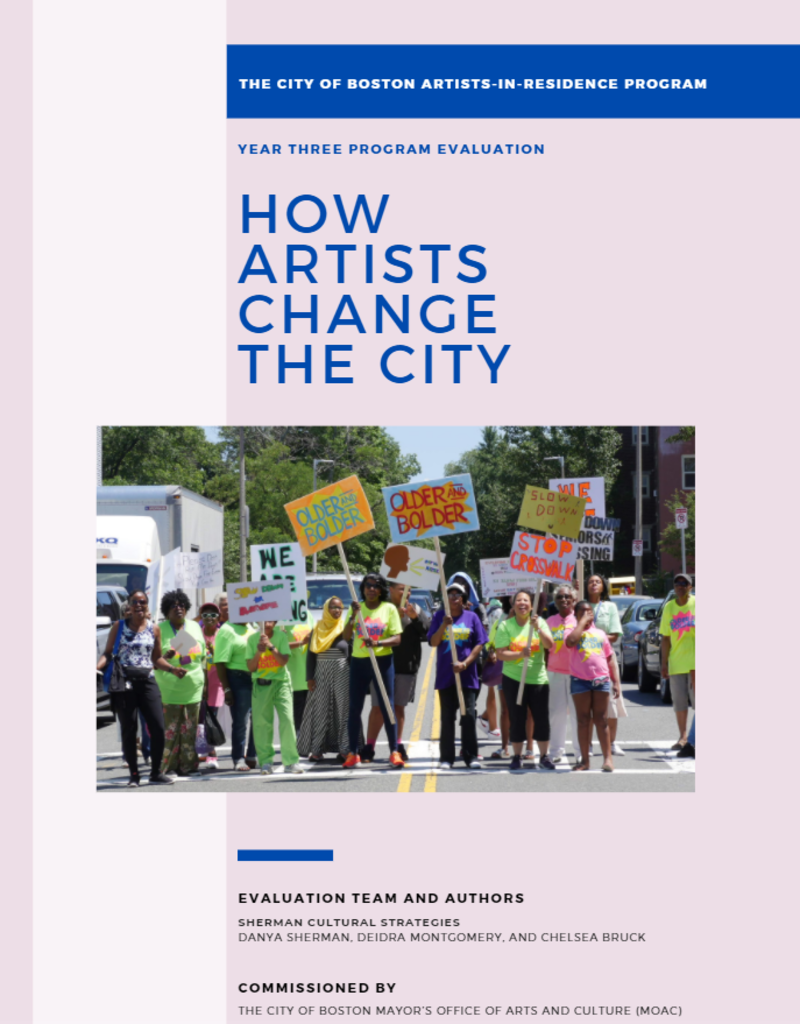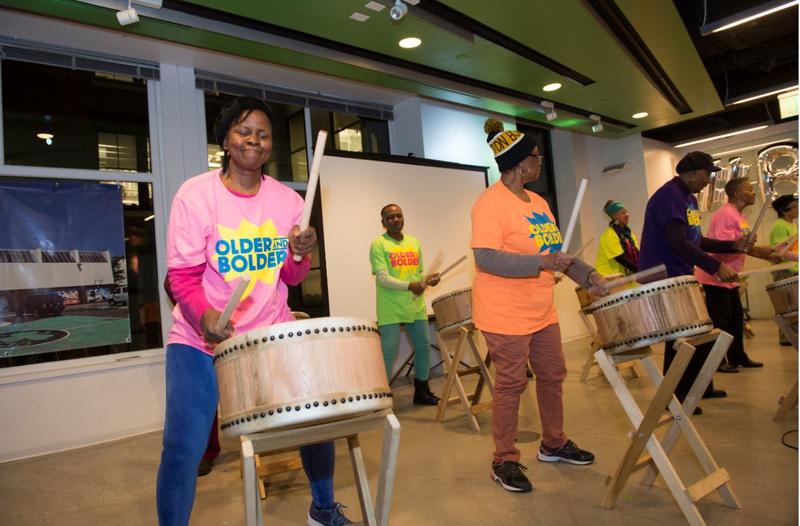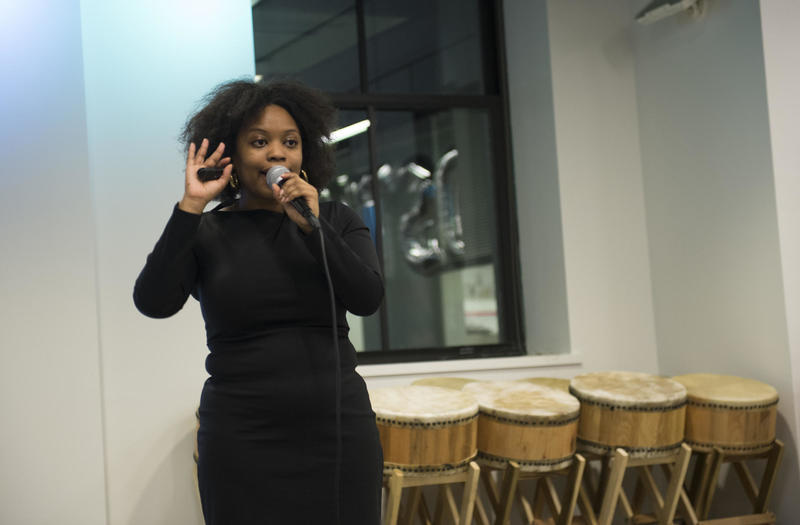Boston AIR: Learning from the past and moving forward
This is a blog post written by Director of Public Art Karin Goodfellow and Boston Boston Artists-in-Residence (AIR) Program Manager Sharon Amuguni highlighting learnings from an evaluation of the Boston AIR program, and changes being made to the residency going forward.
We are currently in the second half of the fourth year of the Boston Artists-in-Residence program, Boston AIR. At the start of 2020, we were proud to say that the structure of the fourth year more closely resembled our vision for the program than any other year. And in March, we felt grateful to even be able to move forward with the program, in any modified form. We understood and continue to acknowledge that it is a privilege to be able to do this work, especially now.
In response to the COVID-19 pandemic and in the spirit of serving our community and listening to artists, Boston AIR will be extending the residencies of the current artists to the end of May 2021, providing the artists and our community members with three additional months to continue their residency work. This extension allows the artists more time to create deep and impactful work, and aligns with overall plans from the leadership team to adjust the residency moving forward. Moving forward, Boston AIR will be a 15 month program, and is adapting to be responsive in other ways.
We wouldn’t have been able to make the necessary changes this year without the years of dynamic, continuously reflexive, and sometimes messy work and learning that came before it. This work has been supported and carried out by 20 artists, over a dozen city colleagues, hundreds of engaged residents, and a dedicated department of friends and allies.
Evaluation
In October of 2018, we sent out a call for evaluators for the third year of the Boston Artists-in-Residence program. This third cohort included seven artists and cultural workers from across the city, who met together over the course of the year to discuss art, policy, and social change using a lens of resilience and racial equity. The artists examined City of Boston policies and attended workshops. Some artists collaborated with City officials and community members at various Boston Centers for Youth and Families (BCYF) sites and other community centers and nonprofits to develop projects. Other artists investigated City processes and advocated for pathways where systems fell short.
Sherman Cultural Strategies, composed of Danya Sherman, Deidra Montgomery, and later, Chelsea Bruck, were chosen through a competitive process to carry out the evaluation and provide potential lessons for future iterations.
Through a multi-year process, which included a series of interviews, surveys, and document reviews, Sherman Cultural Strategies authored the written text for the evaluation. That text has been bolstered here through visual design by our Communications Fellow, Veronica Wells, to create a more accessible, reader-friendly version. We invite community members to read the following evaluation in hopes that it both provides a greater understanding of this type of civic work and adds to our collective learning around partnerships between artists and municipalities.
The evaluation report is one tier of a multi-layered, in-depth reflection and evaluation process that occurred from 2018 to 2019.
Reflection and active listening
The formal evaluation was helpful and validating; however, reflection and conversations with trusted colleagues and artists supported the iterative, demanding, and loving process that guided us. We’d like to thank former AIRs Rashin Fahandej, Karen Young, and Shaw Pong Liu, who generously gave their time and shared their expertise during honest conversations. Many of the learnings from those discussions and others with current and former artists have informed the fourth year of the program and continue informing planning for the fifth year, in conjunction with the evaluation report.
In addition to these meaningful exchanges with former artists, we took into consideration suggestions from our colleagues. We received valuable feedback from team members, including Chief of Arts and Culture, Kara Elliott-Ortega. Chief Elliott-Ortega pushed our thinking during planning conversations and interacted with the cohort during internal meetings reflection sessions. Understanding that partnership was a core element of this work, we also engaged in active listening with City officials who worked directly with an artist through the program, along with non-City arts administrators leading and organizing arts-based cohorts operating under a lens of social justice.
This process also involved assessing prior years in practical ways, asking ourselves what things worked, and what things didn’t. How many people make a cohort feel connected and intimate? How many monthly meetings let partners feel heard without feeling micromanaged? What does it look like to have a physical space? What does it mean to be “in-residence” with the City? How much time is enough time for this work?
This type of reflection was done by the leadership team each year, resulting in the first three cohorts and structures looking notably different. We now view this process as unintentional piloting, a byproduct of a responsive approach.
During the first year, three artists worked closely with specific City departments, developing residencies that brought constituents into City systems. During Boston AIR’s second year, a cohort of ten artists worked within BCYF centers, often addressing the immediate needs of those distinct neighborhoods and communities, and seeing how policy impacts the lived experiences of Bostonians. During the third year, seven artists were given the opportunity to connect to a BCYF center, in order to be in direct conversation with residents impacted by City policy, but were also asked to incorporate resilience and racial equity into their work.
Each year provided invaluable knowledge, which was reinforced by the research done by Sherman Cultural Strategies during the third year. This allowed us to build a program structure for the fourth year that was backed by outside research, learned experiences, sincere feedback, and a responsive approach.
Lastly, in this evaluation process, we acknowledged our capacity as the leadership team. This meant being intentional about building a structure that allowed room for breath, and one that felt sustainable to us as stewards of the program. We were deliberate in our planning. We aimed to create a program structure that, if replicated by other municipalities, wouldn’t leave administrators feeling overtaxed and cohort members feeling underserved.
This fourth year was upheld by the clarity developed through the process, and integrates what we've learned from previous years as core themes: supporting collaborative and democratic creation of City policy, process, and practice (Year 1), understanding how local government policy impacts Bostonians (Year 2), and examining City policies with a lens of resilience and racial equity (Year 3).
Looking Ahead
We want to thank community members for standing by us throughout this process, throughout years of experimentation, piloting, growing and evolving and supporting residency projects that reimagined a more creative and equitable Boston. We are grateful to our artists from the first three years of the program.
And of course, we thank this current cohort, Victor Yang, Golden, Erin Genia, Pat Falco, Anthony Romero, and their City partners Tania Mireles, Kyron Owens, Wandy Pascoal, and Carol Leon. We also want to thank everyone at the Mayor’s Office of Arts and Culture who continue to build community and do this important work, especially Kristina McGeehan, our Communications Director who has been a thought partner and advocate for this work. Despite current communication challenges, she supports us in exploring new methods of engaging our community.




